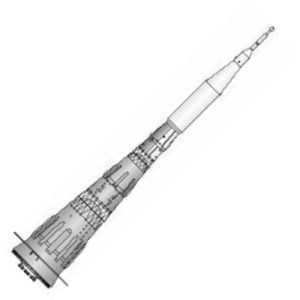
Home - Search - Browse - Alphabetic Index: 0- 1- 2- 3- 4- 5- 6- 7- 8- 9
A- B- C- D- E- F- G- H- I- J- K- L- M- N- O- P- Q- R- S- T- U- V- W- X- Y- Z
N-1 11A52
 N1-L3 - 1964 N1-L3 as per advanced project, 1964 |
First Launch: 1969-02-21. Last Launch: 1972-11-23. Number: 4 .
More at: N-1 11A52.
Country: Russia. Launch Sites: Baikonur, Baikonur LC110R, Baikonur LC110L.
1969 February 21 - . 09:18 GMT - . Launch Site: Baikonur. Launch Complex: Baikonur LC110R. LV Family: N1. Launch Vehicle: N-1 11A52. FAILURE: First stage failure.. Failed Stage: 1.
- N1 3L launch - .
Payload: Soyuz 7K-L1S s/n 3. Mass: 6,900 kg (15,200 lb). Nation: Russia.
Related Persons: Afanasyev, Sergei,
Dorofeyev,
Kirillov,
Mishin.
Agency: RVSN.
Program: Lunar L3.
Class: Manned.
Type: Manned spacecraft. Spacecraft Bus: Soyuz.
Spacecraft: Soyuz 7K-L1A.
Decay Date: 1969-02-21 . Apogee: 30 km (18 mi).
N-1 serial number 3L was the first N-1 launched. The vehicle ran into trouble immediately at lift-off. A fire developed in the tail compartment. The engine monitoring system detected the fire, but then gave an incorrect signal, shutting down all engines at 68.7 seconds into the flight. British intelligence detected the launch attempt, but the CIA's technical means for some reason missed it and they denied for years that it had ever occurred. In retrospect the launch team at Baikonur pointed to a grave mistake - at the christening of the first N1, the champagne bottle broke against the crawler-transporter rather than the hull of the rocket. After the 3L failure everyone knew there was no chance at all of beating the Americans to the moon. Additional Details: here....
1969 July 3 - . 20:18 GMT - . Launch Site: Baikonur. Launch Complex: Baikonur LC110R. LV Family: N1. Launch Vehicle: N-1 11A52. FAILURE: First stage failure.. Failed Stage: 1.
- N1 5L launch - .
Payload: Soyuz 7K-L1S s/n 5 / Dummy LK. Mass: 6,900 kg (15,200 lb). Nation: Russia.
Agency: RVSN.
Program: Lunar L3.
Class: Manned.
Type: Manned spacecraft. Flight: Apollo 11.
Spacecraft Bus: Soyuz.
Spacecraft: Soyuz 7K-L1A.
Decay Date: 1969-07-03 .
N-1 serial number 5L began to fail at 0.25 second after liftoff when the oxidizer pump of engine number 8 ingested a slag fragment and exploded. A fire ensued as the vehicle climbed past the top of the tower. Engines were shutdown until the acceleration dropped below 1 G; then the vehicle began to fall back to the pad at a 45 degree angle. The escape tower fired at the top of the brief trajectory, taking the L1S dummy descent module away from the pad. Upon impact of the base of the N1 with the pad, the vehicle exploded, destroying launch pad 110 east, which would take over 18 months to repair. This was the end of a slight Soviet hope of upstaging the US Apollo 11. Additional Details: here....
1971 June 26 - . 23:15 GMT - . Launch Site: Baikonur. Launch Complex: Baikonur LC110L. LV Family: N1. Launch Vehicle: N-1 11A52. FAILURE: First stage failed.. Failed Stage: 1.
- N1 6L - .
Payload: Soyuz 7K-LOK / LK Mockups. Mass: 9,850 kg (21,710 lb). Nation: Russia.
Agency: RVSN.
Program: Lunar L3.
Class: Manned.
Type: Manned spacecraft. Spacecraft Bus: Soyuz.
Spacecraft: Soyuz 7K-LOK.
Decay Date: 1971-07-21 . Apogee: 1.00 km (0.60 mi).
Superbooster failure of N1 serial number 6L. This was a substantially improved vehicle, incorporating filters in the propellant lines to prevent any foreign objects from getting into the pumps. The shape of the tail of the booster was modified, and ventilation and refrigeration systems were added to keep the engine compartment cool. It was painted white overall to reduce temperatures while sitting on the pad. After liftoff and ascent, an axial rotation was introduced by gas dynamics interactions of the thirty engines with the air slipstream. The launch vehicle developed a roll beyond the capability of the control system to compensate. and began to break up as it went through Max Q. Control was lost at 50.2 seconds into the flight and it was destroyed by range safety a second later. The engines functioned well and did not shut down up to the point of vehicle destruction. No functional payload was carried. It has been stated that this launch did not have a working launch escape system. Additional Details: here....
1972 November 23 - . 06:11 GMT - . Launch Site: Baikonur. Launch Complex: Baikonur LC110L. LV Family: N1. Launch Vehicle: N-1 11A52. FAILURE: Failure. Failed Stage: 1.
- N1 7L - .
Payload: Soyuz 7K-LOK / LK Mockups. Mass: 9,850 kg (21,710 lb). Nation: Russia.
Agency: RVSN.
Program: Lunar L3.
Class: Manned.
Type: Manned spacecraft. Spacecraft Bus: Soyuz.
Spacecraft: Soyuz 7K-LOK.
Decay Date: 1972-11-23 . Apogee: 40 km (24 mi).
Unmanned test of manned lunar mission launch vehicle serial number 7L. This article incorporated significant changes to the previous model, including roll 'steering' engines to prevent the loss of control that destroyed 6L. The rocket ascended into the sky, and the engines ran 106.93 seconds, only seven seconds before completion of first stage burnout. Programmed shutdown of some engines to prevent overstressing of the structure led to propellant line hammering, rupture of propellant lines, and an explosion of engine number 4. The vehicle disintegrated. Additional Details: here....
Back to top of page
Home - Search - Browse - Alphabetic Index: 0- 1- 2- 3- 4- 5- 6- 7- 8- 9
A- B- C- D- E- F- G- H- I- J- K- L- M- N- O- P- Q- R- S- T- U- V- W- X- Y- Z
© 1997-2019 Mark Wade - Contact
© / Conditions for Use